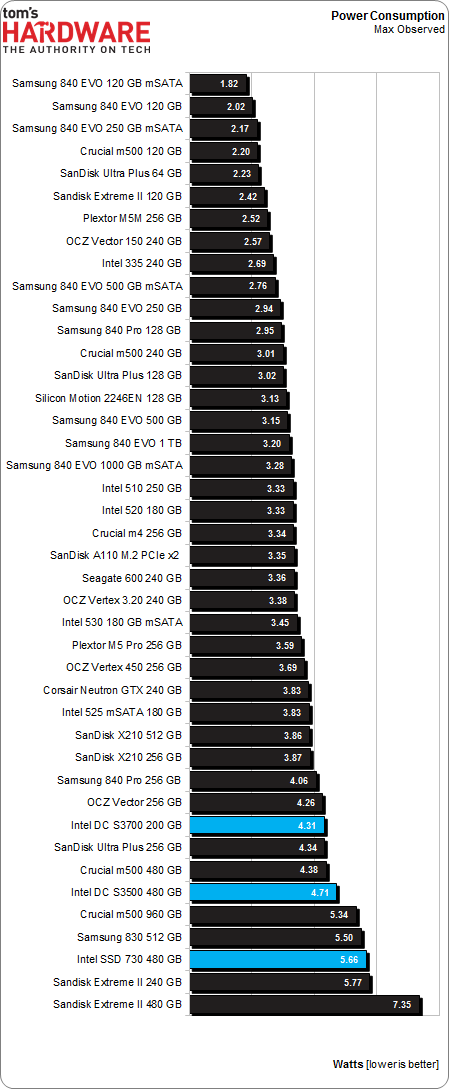The SSD 730 Series Review: Intel Is Back With Its Own Controller
Power Consumption
Idle Power Consumption
Idle consumption is the most important power metric for consumer and client SSDs. After all, solid-state drives complete host commands quickly, and then drop back down to idle. Aside from the occasional background garbage collection, a modern SSD spends most of its life doing very little. Enterprise-oriented drives are more frequently used at full tilt, making their idle power numbers less relevant. But this just isn't the case on the desktop, where the demands of client and consumer computing leave most SSDs sitting on their hands for long stretches of time.
Active idle power numbers are critical, especially when it comes to their impact on mobile platforms. Idle means different things on different systems, though. Pretty much every drive we're testing is capable of one or more low-power states, up to and including DevSleep. That last feature is a part of the SATA 3.2 host specification. And while it requires a capable SSD and a compatible platform, enabling it takes power consumption down to a very small number.
Intel's SSDs are immediately split into two groups: the SSD DC S3500 and S3700 in the middle, and the SSD 730 at the very bottom. A higher controller clock rate and faster NAND interface demand a corresponding increase in power consumption. So, the performance-oriented SSD 730 registers the highest idle power use of any drive we've tested. That's not necessarily a big deal in a desktop or workstation, but it's probably going to keep you from installing one of these in a notebook.
PCMark 7 Average Power Consumption
If we log power consumption through a workload, even a relatively heavy one, we see that average use is still pretty close to the idle numbers. Maximum power may spike fiercely, but the draw during a PCMark 7 run is pretty light. You can see the drives fall back down to the idle "floor" between peaks of varying intensity.
All three Intel drives are fast, addressing PCMark 7's storage test and dropping back to idle quickly. That helps even out the average power consumption measurement through our run. Then again, the SSD 730 Series pulls nearly twice as much power as Intel's SSD DC S3x00s.
More aggressive performance specs register as a big jump in idle power consumption, especially. Though, given the intended enthusiast and prosumer audiences, we're not really sure how much of a knock that should be. As we've seen from other vendors, going all-out for the best possible results is a viable approach, so long as you know where the hardware is appropriate and where other options are more apropos.
Get Tom's Hardware's best news and in-depth reviews, straight to your inbox.
Maximum Observed Power Consumption
The SSD 730 brings up the rear yet again, posting peak figures in excess of almost every other SATA-based drive. In the grand scheme of things, though, none of these SSDs use much power. In some sort of battery-powered devices, sure, you'd be looking at a problem. But in a desktop application, the hundreds of watts used by overclocked CPUs and graphics cards are more statistically relevant.
Current page: Power Consumption
Prev Page TRIM Testing Next Page It's Expensive, It Uses A Lot Of Power, But It's Fast-
blackmagnum That skull on an Intel SSD means this product is the Big Kahuna. Samsung just cannot crush this competition.Reply -
Amdlova that 480 drain more than a 5400rpm HDD. Samsung or sandisk for laptops. Please next SSDReply -
rokit Never expected Intel to fail like that. Samsung still offers the best performance/power consumption/$Reply
I guess that skull did the job, power of signs )
p.s. this site has level editing in non-forum mode(the one you see and use by default)
Watch the language. - G -
mamasan2000 I don't see why the Intel SSD is any good. It's midpack at best at everything. Even my cheap Sandisk is better and it was the cheapest SSD I could get around here (besides Kingston).Reply -
unityole how is samsung the best? http://www.tweaktown.com/blogs/Chris_Ramseyer/58/real-world-ssd-performance-why-time-matters-when-testing/index.htmlsandisk and toshiba SSD, look at the chart and see the performance for yourself. Evo doing well, but thats only cause of the SLC flash helping it.Reply -
eriko All this Samsung love here... I have two brand new 840 Evo 250GB drives, and they are garbage.In fact they are so poor, I had to separate all my files, and break the RAID,and have two individual volumes, so as to have Trim enabled, and also Magician running, otherwise, terrible read and write (especially) performance resulted. I did verify they were genuine drives too. As soon as you begin to fill up these 250GB Evos, performance falls off a cliff.I'm now not a believer in TLC, and wish I had waited to get the Pro's (not available in this part of the world), as I hear much better things about them.But I've had my fill of reading reviews on consumer drives, I'm going to California in a week or so, and so I will either get 2 x 400GB S3700's, or a single 800GB S3700 (and to hell with RAID). Enterprise drives are the bomb, and don't forget that. Lost way too much time and data now with 'consumer' drives...By the way, X25E 64GB still going strong without so much as a hiccup. Not even a burp... If they made a 640GB X25E, I think I'd suck their, ok, I won't say that but you get the idea.Reply -
zzzaac Just curious, this speed, would you be able to tell that it is faster, or is it just though benchmarks?.This ssd is quite expensive at my local parts shopReply



